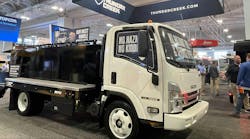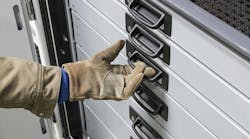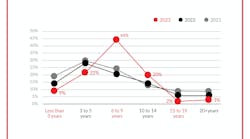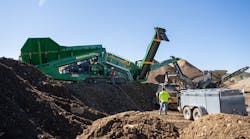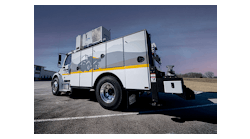Service trucks literally drive field maintenance activities, and specifying these work trucks requires not only an understanding of truck chassis, but also of the bodies and accessories those chassis carry. Truck builders take a chassis, customize the body, and attach the various accessories specific to each fleet’s needs.
As with the iron they support, field service trucks are also undergoing design and technology changes in an effort to make them more efficient, safe, and cost-effective. Here are three key ways that service trucks are being fine-tuned for field maintenance.
Weight management
When specifying service trucks, maintenance managers should balance the load economy of lighter weight aluminum or composite materials with the durability and high strength of steel. Reduced-weight trucks may provide better fuel and consumables economy and allow for added overall storage and accessories weight, but managers must consider the truck’s structural integrity for the applications in which it will be used.
IMT says it is important to understand the baseline weight when configuring the truck because there are considerable differences between weights of bodies and the weight of features packages, cranes, compressors, welders, fluids storage, and payloads.
While IMT continues to strive to reduce the overall weight of the unit package and improve the lift-to-weight ratio of its cranes, the company prefers to use materials that will last longer, be more reliable, more durable, and more cost-effective than an alternative material that may provide a minimal weight reduction but not prove as durable in the long run. The company says they are cognizant of the weight-saving materials available, and are researching and testing various material combinations that will enhance safety and stability as well as improve the equipment’s operation.
In cases where corrosion is a defining factor in a fleet manager’s choice of a crane-equipped service truck, aluminum bodies can be the solution.
Stellar Industries’ TMAX Aluminum series bodies are selling at a rate that is double what the company expected, according to Tim Davison, product manager.
The key to lighter bodies with less potential for corrosion means designing the body without compromising the structure that supports the service crane.
“Stellar has always used the Torque Isolator crane support system that takes the energy from the crane and transfers it to the chassis frame and stabilizers through an independent crane compartment and a full-length torsion box,” Davison says. “The system also does not transfer load through the side compartments. The side compartments basically ‘go for a ride’ and are not integral in supporting the crane.”
The TMAX Aluminum series incorporates the latest in aluminum manufacturing technology in the body side compartments, according to the company, while maintaining steel for the understructure and crane compartment. Davison says the hybrid build structure saves up to 1,200 pounds of weight on larger bodies such as the TMAX 2-14 Aluminum unit.
Limited accessibility on a work site or on an emergency job can hinder how much assistance a crane-equipped service truck can provide. With that in mind, IMT has added a new Dominator mechanics truck to
its series.
The Dominator III is 3 feet shorter and 500 pounds lighter than its 14-foot counterpart, but it still handles 12,000 pounds with its 25-foot telescopic.
The Dominator III body design was driven by a market demand for a maneuverable truck that provides capabilities and support of a larger service truck with the ability to meet tight application, according to the company. The 11-foot Dominator III has the same 81,000-lb.-ft. crane rating as the longer Dominator.
Innovative features
Options and technology that enhance the operator’s experience and ease of use include what IMT calls “intentional enhancements.”
One example is how IMT improved its integrated LED high-intensity lighting strips that are standard inside the body’s storage compartments. IMT painted the interior of the storage compartments with a polyurethane-modified multicolor spray finish that prevents the LED light from reflecting within the compartment and creating a glare, causing poor views of the box’s contents and causing significant eye strain. For crane operations support, Stellar’s Crane Dynamics Technology integrates proprietary technology into its service trucks, providing operators with accurate real-time load feedback.
The lightweight handheld wireless transmitter displays real time data such as load capacity, maximum distance with the current load, boom angle, and percentage of load.
“Our CDTplus system gives operators immediate feedback on their handheld transmitter that shows them the actual load weight of the item they are lifting, plus tells them how far they can move that object,” Davison says. “In fact, our crane-control system allows operators to know the crane’s capacity wherever the crane hook is dangling. The operator can have a relatively good idea of the crane’s capacity at any given position prior to attempting a lift. If they can estimate an item’s weight, the CDTplus can indicate the crane’s ability to lift the load before they ever hook it up to the crane.”
Stellar’s CDTplus (see video below) alerts the operator of increasing loads before they reach maximum capacity. If the CDTplus sensors detect maximum capacity, the system will “boost” the crane to 118 percent of its normal operating mode for a short period of time. If the system senses the crane is operating incorrectly, it will automatically put the crane in safe mode, which will allow the operator to work at a reduced speed until the problem is addressed.

